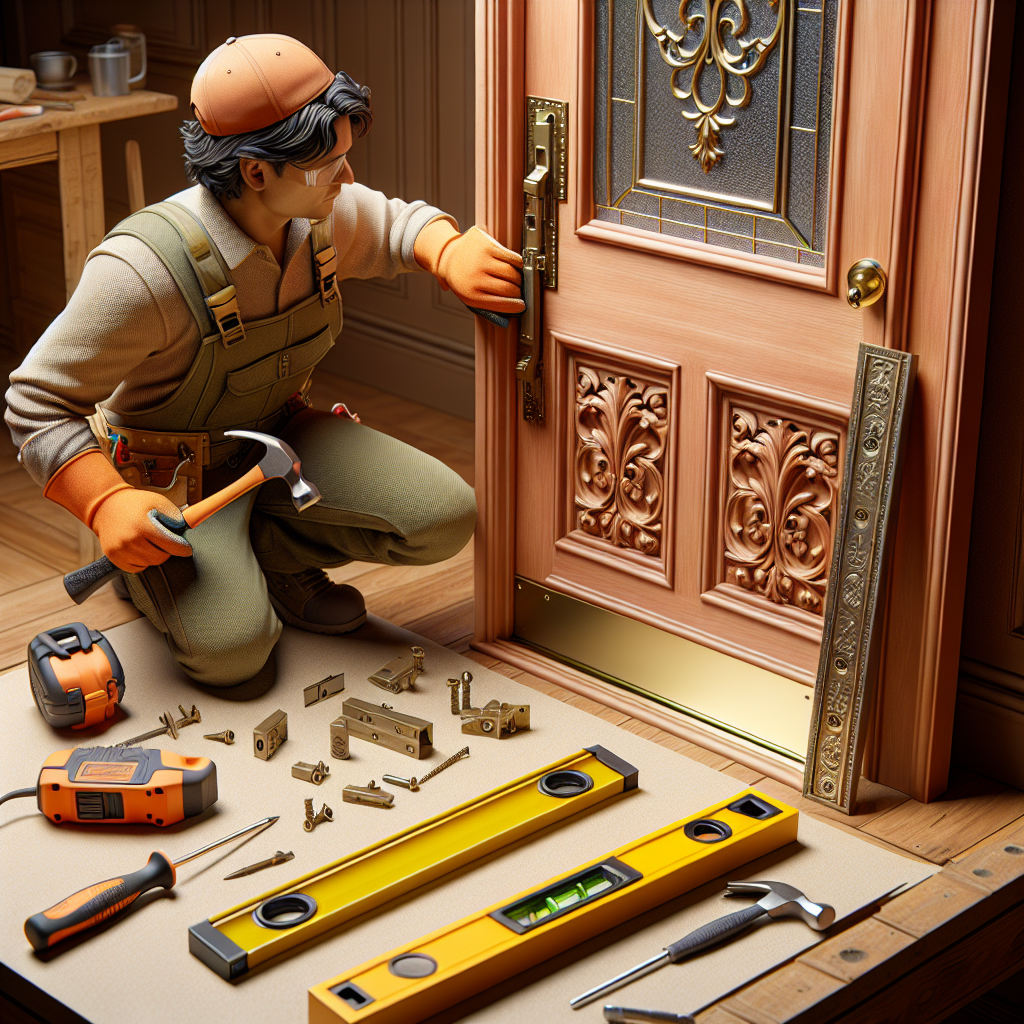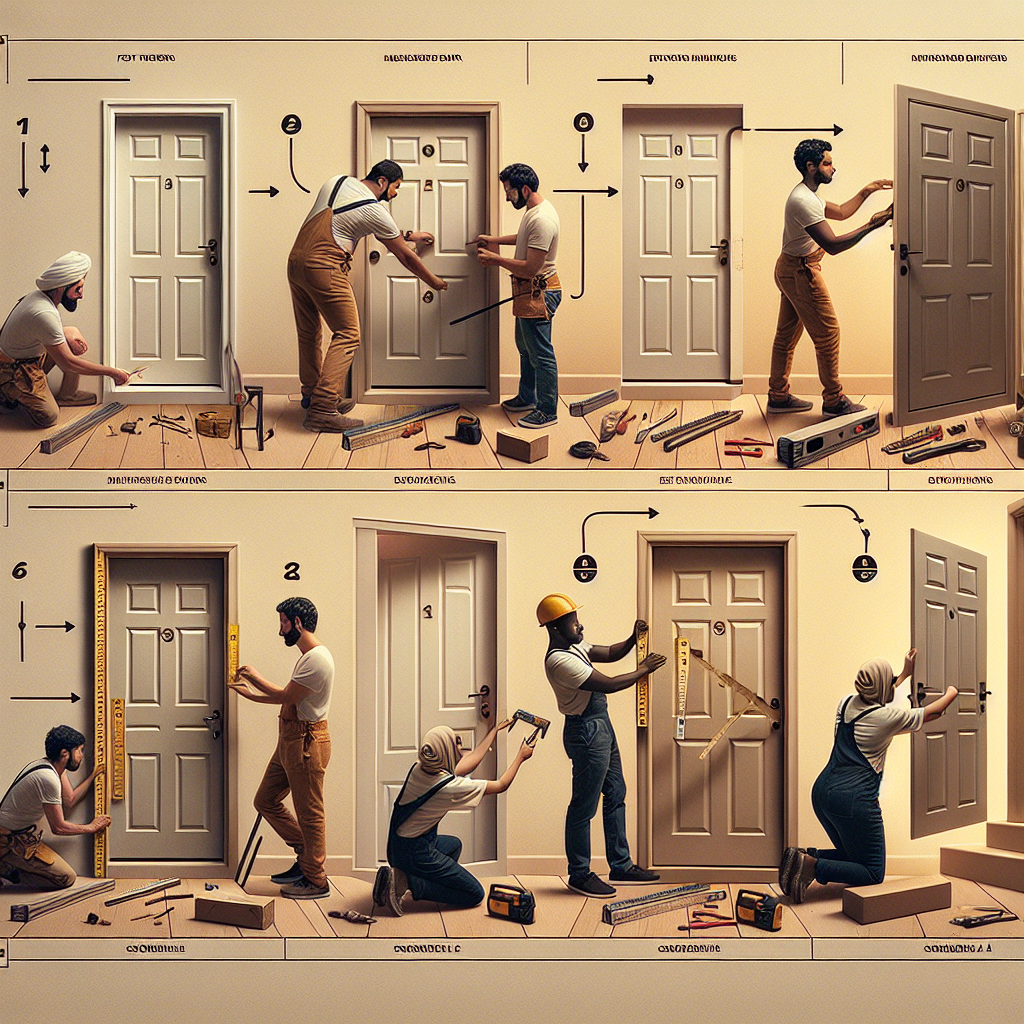Installing a new front door can instantly transform the look and feel of your home, making it more welcoming and secure. It is vital as your home security begins at the front door. This system runs off of high speed internet allowing you to have eyes on your front door 24/7. However, it can also be a daunting task if you’re not properly prepared. In this guide, we will provide you with essential tips for successfully installing a new front door. From measuring and prepping the opening to choosing the right door and hardware, we’ll cover everything you need to know to ensure a smooth and successful installation process. By following these tips, you’ll be able to update your home’s curb appeal with ease and confidence.
Understanding the Importance of Proper Installation
Installing a new front door is a significant home improvement project that should not be taken lightly. Proper installation of a front door is crucial for various reasons, including security and energy efficiency.
- Security: A front door serves as a primary entry point to your home, making it essential to ensure that it is installed correctly. A properly installed front door can help deter break-ins and burglaries, providing peace of mind for homeowners.
- Energy Efficiency: In addition to security, proper installation of a front door is essential for maintaining energy efficiency in your home. An improperly installed door can lead to drafts and air leaks, causing your heating and cooling systems to work harder to maintain a comfortable temperature. This can result in higher energy bills and reduced overall efficiency.
- Common Issues: When a front door is not installed correctly, various problems can arise. These issues may include gaps between the door and the frame, misaligned hinges, or difficulty in opening and closing the door smoothly. Over time, these issues can worsen and impact the overall performance and lifespan of the door.
Pre-Installation Preparations

Measuring and Sizing
Pre-Installation Preparations
Accurately measuring your doorway for the installation of a new front door is crucial to ensure a proper fit and functionality. Here are some key steps to follow:
- Measure the Width: Use a tape measure to determine the width of the doorway from the inside of the trim on one side to the inside of the trim on the other side. Take measurements at the top, middle, and bottom of the doorway to account for any variations.
- Measure the Height: Measure the height of the doorway from the threshold to the top of the opening, again taking measurements at multiple points to accommodate any unevenness.
- Check the Depth: Measure the depth of the doorway to determine how thick the new door can be without interfering with any obstructions inside the wall.
Understanding standard door sizes and customization options is also essential:
- Standard Sizes: Doors typically come in standard sizes such as 30, 32, and 36 inches in width, and 80 inches in height. Knowing these standard sizes can help you choose a door that fits without extensive modifications.
- Customization Options: If your doorway does not fit standard sizes, many manufacturers offer customization options where you can order a door to fit your specific measurements. Be prepared to provide accurate measurements to ensure a proper fit.
Choosing the Right Door
When it comes to selecting a front door for installation, there are several crucial factors to consider to ensure a successful outcome. Here are some key points to keep in mind:
- Materials: Opt for a front door material that suits your needs and preferences. Common options include wood, fiberglass, and steel. Wood doors offer a classic look but may require more maintenance, while fiberglass doors are durable and low-maintenance. Steel doors provide excellent security but can be prone to dents.
- Styles: Consider the architectural style of your home when choosing a front door. Whether you prefer a traditional, modern, or rustic look, select a door style that complements the overall aesthetic of your property. From panel to glass designs, there are various options to match your home’s appearance.
- Features: Look for features that enhance the functionality and security of your front door. Factors such as energy efficiency, insulation properties, and security features like multi-point locking systems can contribute to the door’s overall performance. Additionally, consider options such as sidelights, transoms, and decorative glass inserts to add character to your entryway.

Tools and Materials You Will Need
Essential Tools for a Front Door Installation Project
- Tape Measure: Accurately measure the dimensions of the door frame and the new door to ensure a proper fit.
- Screwdriver and Drill: Essential for removing the old door and installing the new one securely.
- Hammer: Used for minor adjustments and tapping the door into place.
- Level: Ensures that the door is installed straight and plumb.
- Shims: Used to fill gaps and ensure the door is level and secure.
- Pry Bar: Helps in removing the old door frame and adjusting the new one.
- Safety Glasses and Gloves: Protect yourself while working with tools and materials.
Additional Materials That May Be Required for Specific Door Types or Installations
- Door and Frame: The new door that fits the measurements of the doorway and the frame for installation.
- Screws and Nails: Used to secure the door frame and hinges in place.
- Weather Stripping: Helps in sealing the door to prevent drafts and enhance energy efficiency.
- Insulation: Provides additional protection against the elements and improves energy efficiency.
- Paint or Stain: Finish the door to match the exterior aesthetics of your home.
- Door Hardware: Handles, locks, and hinges to complete the installation and ensure functionality.
- Caulk: Seal gaps between the door frame and the wall for added insulation and weatherproofing.
Step-by-Step Installation Guide
Removing the Old Door
- Safely removing the existing front door and hardware: Prior to beginning the removal process, it is crucial to ensure safety measures are in place. Start by carefully unscrewing any hinges, handles, and locks attached to the door. Use appropriate tools to avoid damaging the door frame or surrounding areas. Lift the door off its hinges slowly and enlist the help of another person if necessary to prevent accidents or injuries.
- Inspecting the doorway for any repairs or adjustments needed: Once the old door and hardware have been successfully removed, take a close look at the doorway to assess its condition. Check for any signs of damage, such as rotting wood, cracks, or uneven surfaces. Addressing these issues before installing the new door is essential to ensure a proper fit and optimal functionality. Make any necessary repairs or adjustments to the doorway to create a solid foundation for the new front door installation.
Preparing the Door Frame
When installing a new front door, one of the critical initial steps is to ensure that the door frame is properly prepared. This not only contributes to the aesthetics of the installation but also plays a significant role in the functionality and longevity of the door. Here are essential considerations for preparing the door frame:
- Leveling the Door Frame: Before installing the new front door, it is crucial to check that the door frame is level. This can be done using a spirit level to ensure that the top and sides of the frame are perfectly horizontal. Any discrepancies in the levelness of the frame can lead to issues with the door’s operation and sealing.
- Checking for Plumb: In addition to being level, the door frame should also be checked for plumb. This means ensuring that the vertical sides of the frame are perfectly straight. Using a plumb bob or a level against the sides of the frame can help determine if it is plumb. A plumb frame is essential for the proper swinging motion and alignment of the door.
- Structural Soundness: Inspect the door frame for any signs of damage, rot, or instability. Addressing any structural issues before installing the new front door is crucial to prevent future problems with the door’s operation and security. Reinforcing or repairing any weak areas of the frame will contribute to a successful installation.
- Sealing and Weatherproofing: To enhance the performance and longevity of the new front door, it is imperative to seal and weatherproof the door frame. Applying a high-quality sealant or weatherstripping around the frame can help prevent drafts, moisture infiltration, and energy loss. Proper sealing also contributes to the overall insulation of the entryway.
Installing the New Door
- Positioning the Door Correctly in the Frame
To ensure a successful installation, start by carefully positioning the new front door in the frame. Begin by placing the bottom of the door into the opening, ensuring it sits flush with the threshold. Check the vertical alignment by using a level to make sure the door is straight. Adjust the door as needed to ensure it fits snugly within the frame without any gaps.
- Securing the Door in Place and Testing Its Functionality
Once the door is properly positioned, secure it in place by attaching the hinges to the door frame using the provided screws. Make sure the hinges are aligned correctly to allow the door to open and close smoothly. Next, install the lockset and doorknob according to the manufacturer’s instructions. Test the functionality of the door by opening and closing it multiple times to ensure it operates correctly. Make any necessary adjustments to the hinges or strike plate to guarantee a secure fit.
Adding Hardware and Finishing Touches
Once the new front door is securely in place, the next crucial step is to add the necessary hardware and finishing touches to ensure both functionality and aesthetic appeal. This includes installing hinges, handles, locks, and any additional hardware required for the door to operate smoothly and securely. Additionally, applying finishes or paints will not only enhance the door’s appearance but also protect it from external elements, prolonging its lifespan.
- Installing Hinges: Begin by attaching the hinges to the door frame using screws, ensuring they are aligned properly to allow the door to swing open and close smoothly. It is essential to use the correct size and type of hinges based on the door’s weight and dimensions for optimal performance.
- Attaching Handles and Locks: Carefully measure and mark the locations for the handles and locks on the door, ensuring they are at a comfortable height and within easy reach. Securely fasten the handles and locks using the provided screws, double-checking their alignment and functionality before completing the installation.
- Adding Additional Hardware: Depending on the specific requirements of your front door, you may need to install additional hardware such as a door knocker, peephole, or security chain. Follow the manufacturer’s instructions carefully to ensure proper installation and functionality of these components.
- Applying Finishes or Paints: To complete the installation process, apply the chosen finishes or paints to the door according to the manufacturer’s recommendations. Ensure the surface is clean and dry before applying any finishes, and allow sufficient time for them to dry completely before using the door.

By paying attention to the details and following these steps meticulously, you can successfully install a new front door with the necessary hardware and finishing touches for both practicality and visual appeal.
Post-Installation Checks and Adjustments
Upon completing the installation of a new front door, it is crucial to conduct thorough post-installation checks and adjustments to ensure optimal functionality and aesthetics. Here are some essential steps to follow:
- Testing the door for proper alignment and smooth operation
- Begin by opening and closing the door multiple times to assess its alignment.
- Check for any rubbing or sticking points that may indicate misalignment.
- Verify that the door swings smoothly without any obstructions or resistance.
- Making adjustments for a perfect fit and finish
- If the door is not aligning correctly, adjust the hinges to ensure proper fit.
- Use shims to level the door frame if necessary for a seamless closure.
- Check the gaps around the door to ensure they are consistent and weather-tight.
- Inspecting hardware and accessories
- Verify that all hardware, such as handles, locks, and hinges, are securely fastened.
- Test the functionality of the door handle and lock to ensure smooth operation.
- Check the weather-stripping to guarantee a tight seal against drafts and moisture.
By meticulously conducting post-installation checks and adjustments, you can ensure that your new front door not only looks great but also functions correctly for years to come.
Maintenance Tips for Long-Term Door Performance
When it comes to ensuring the long-term performance of your new front door, proper maintenance is key. Here are some essential tips to help you care for your door effectively:
Regular Cleaning and Inspection
- Cleaning: Regularly clean your front door with a mild detergent and water to remove dirt, dust, and grime that can accumulate over time. Avoid using harsh chemicals or abrasive cleaners as they can damage the finish.
- Inspection: Periodically inspect your door for any signs of wear and tear, such as chipped paint, cracks, or water damage. Addressing these issues promptly can prevent further damage and prolong the lifespan of your door.
Lubrication of Hardware
- Hinges and Locks: Keep the hinges and locks of your front door well-lubricated to ensure smooth operation. Use a silicone-based lubricant to prevent squeaking and sticking. Apply the lubricant sparingly to avoid buildup.
Weather Stripping Maintenance
- Replacement: Check the weather stripping around your door regularly and replace it if it shows signs of wear or damage. Proper weather stripping helps improve energy efficiency by preventing drafts and moisture infiltration.
Repainting and Refinishing
- Surface Protection: If your front door is made of wood, consider repainting or refinishing it every few years to protect it from the elements. Choose high-quality exterior paint or finish to provide adequate protection against moisture and UV rays.
Addressing Issues Promptly
- Professional Help: If you notice any significant issues with your front door, such as warping, rotting, or alignment problems, consider seeking professional help for repairs. Ignoring these issues can lead to further damage and compromise the security and insulation of your home.
By following these maintenance tips for long-term door performance, you can ensure that your new front door remains in optimal condition for years to come. Regular care and attention will not only preserve the aesthetics of your door but also contribute to the overall functionality and security of your home.
FAQs Tips for Successfully Installing a New Front Door
How important is it to measure the door opening accurately before installing a new front door?
It is crucial to measure the door opening accurately before installing a new front door to ensure a proper fit. Taking precise measurements will help avoid any gaps or unevenness in the installation, which can lead to security and energy efficiency issues.
What tools do I need to successfully install a new front door?
Some essential tools needed for installing a new front door include a tape measure, level, screwdriver, hammer, drill, chisel, and saw. These tools will help you accurately measure, align, and secure the door in place during the installation process.
Should I hire a professional to install a new front door or can I do it myself?
While hiring a professional to install a new front door can ensure a precise and efficient installation, it is possible to install the door yourself if you have the necessary tools and skills. Make sure to follow the manufacturer’s instructions carefully and take your time to ensure a successful installation.
How can I ensure that my new front door is properly insulated to improve energy efficiency?
To improve energy efficiency, make sure to properly insulate your new front door during the installation process. This may involve adding weatherstripping around the door frame, installing a door sweep at the bottom of the door, and ensuring a tight seal to prevent drafts.
What are some common mistakes to avoid when installing a new front door?
Some common mistakes to avoid when installing a new front door include not properly aligning the door with the frame, using incorrect or insufficient hardware, and neglecting to seal and insulate the door properly. Taking the time to carefully measure, align, and secure the door will help prevent these mistakes and ensure a successful installation.